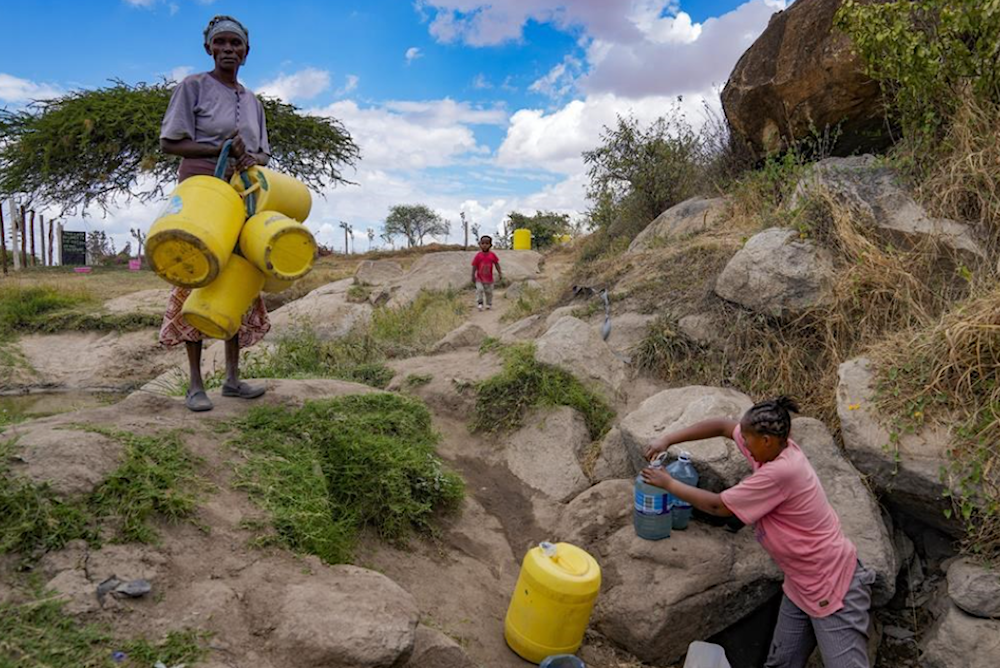People 'paying terrible price' for climate inaction: Guterres
According to #AntonioGuterres, record heat is "turning forests into tinder boxes."
-

Joyce Ngui, left, fetches water in the Athi River, Machakos county, in Kenya on October 17, 2023. (AP)
UN Secretary-General Antonio Guterres has once again raised the alarm about global warming, saying that humanity is already "paying a terrible price" for failing to act on the matter.
The UN Environment Programme (UNEP) issued a new study on Thursday citing all-time high greenhouse gas emissions documented in the UN Emissions Gap study 2024, asking world leaders to take immediate action to avert catastrophic rises in temperatures and avoid the worst impacts of climate change.
Guterres stated in a recorded statement during the publication of the UNEP's Emissions Gap report that the emissions gap is not an abstract concept, emphasizing that "there is a direct link between increasing emissions and increasingly frequent and intense climate disasters," asserting that the report clearly showed "there can be no more playing for time. We are out of time."
"Around the world, people are paying a terrible price," he stated, detailing how these emissions mean record temperatures that fuel "monster hurricanes," and "biblical floods."
He cautioned that "Record heat is turning forests into tinder boxes," likening the situation to walking a tightrope.
"Either leader bridge the emissions gap or we plunge headlong into climate disaster, with the poorest and most vulnerable suffering the most," Guterres said, describing that there was still hope if the world's leading economies take the lead in efforts to reduce greenhouse gas emissions.
"Today's report shows affordable, existing technologies can achieve the emissions reductions we need to 2030 and 2035 to meet the 1.5°C limit, but only with a surge in ambition and support," he explained.
Unprecedented level of collaboration needed
According to the UNEP research, increasing solar photovoltaic and wind energy utilization would provide 27% of total greenhouse gas reductions in 2030 and 38% by 2035. Furthermore, research implies that forest protection might account for around 20% of the necessary reductions in both years.
Other viable measures for reducing greenhouse gas emissions include increasing energy efficiency, electrifying various sectors, and moving away from fossil fuels in buildings, transportation, and industry.
The research, however, noted that attaining even a portion of this potential will need unprecedented levels of collaboration among world leaders, with a focus on maximizing socioeconomic and environmental gains while minimizing trade-offs.
According to UNEP Executive Director Inger Andersen, "We need global mobilization on a scale and pace never seen before, starting right now."
She stated that if world leaders do not act on climate change, mankind would face a disastrous 3.1°C temperature rise.
Microplastics crisis: Pollution levels could double by 2040
Microplastics have infiltrated every environment on Earth, and contamination from this pollution is projected to worsen.
According to a new study published in the journal Science, microplastic pollution could more than double by 2040, highlighting the urgent need for regulations.
This review, which encompasses over 20 years of research on microplastics, emphasizes the necessity for global action to address the spread of these tiny plastic particles.
"Environmental contamination could double by 2040 and widespread harm has been predicted," the researchers noted in the paper.
"Twenty years after the first publication using the term microplastics, we review current understanding, refine definitions, and consider future prospects," they added.
Microplastics are small plastic particles, usually measuring less than 5 millimeters, that come from the degradation of larger plastic products or are intentionally created for industrial purposes. It is estimated that approximately 40 megatons of microplastics are released annually.
These particles have been found in diverse environments globally, including oceans, rivers, soil, tap water, food, animals, the air we breathe, and even within the human body. Their minuscule size makes them extremely difficult to eliminate from the environment, and they have the potential to accumulate in food chains.

 4 Min Read
4 Min Read









